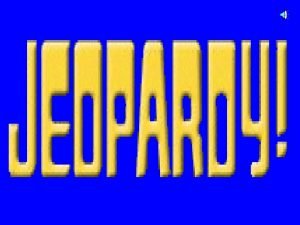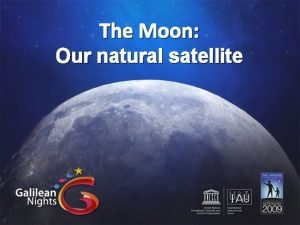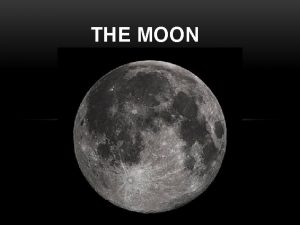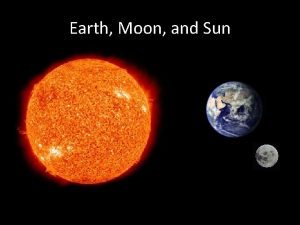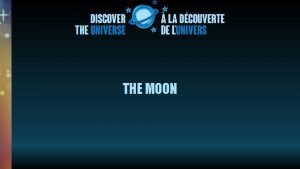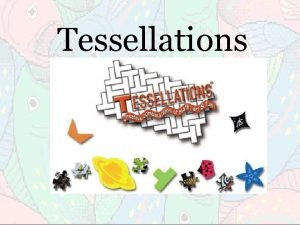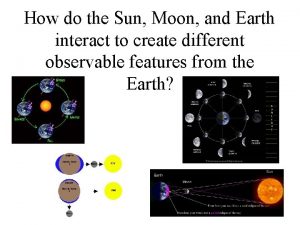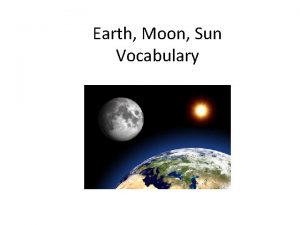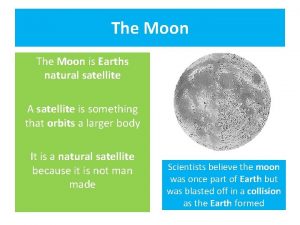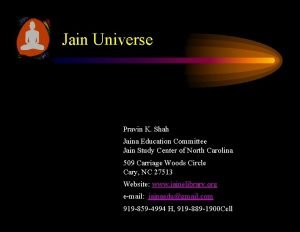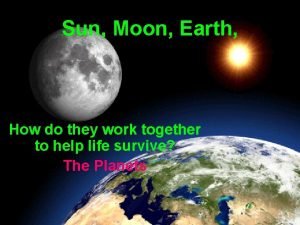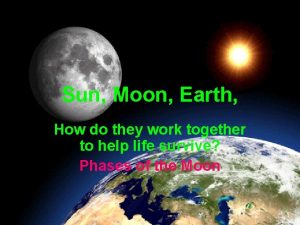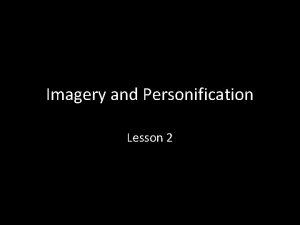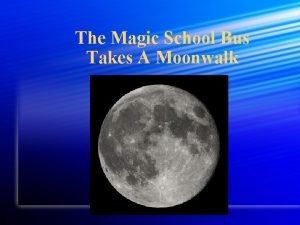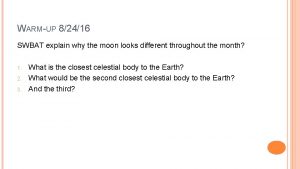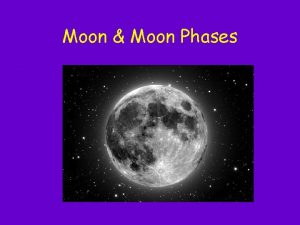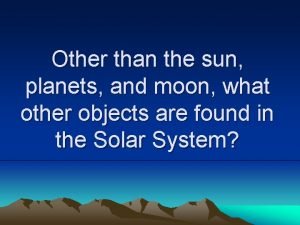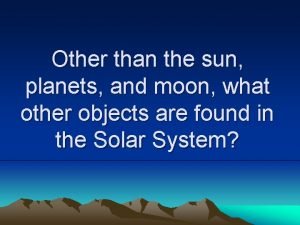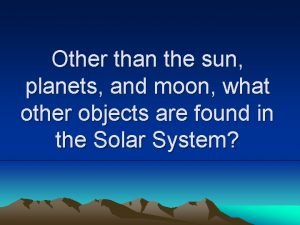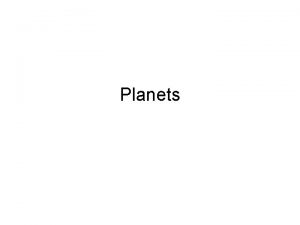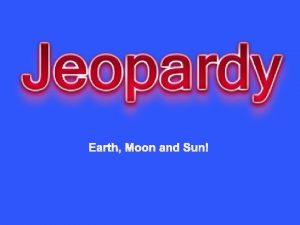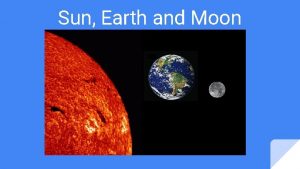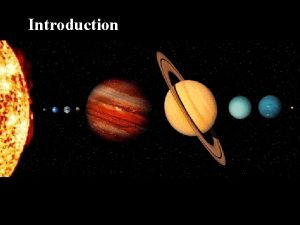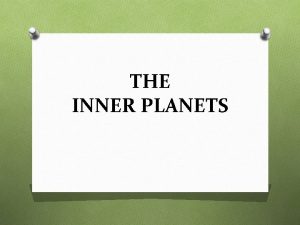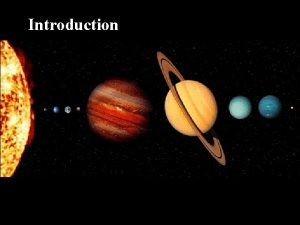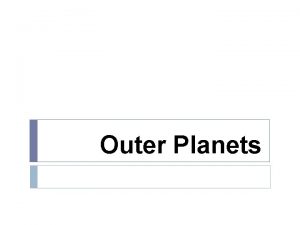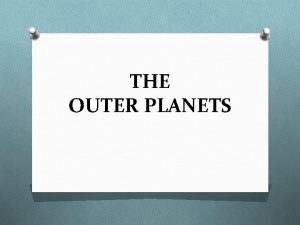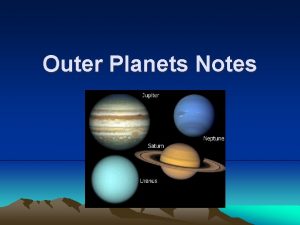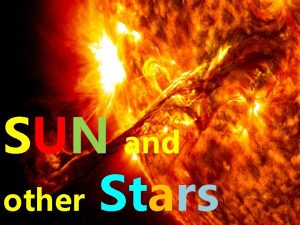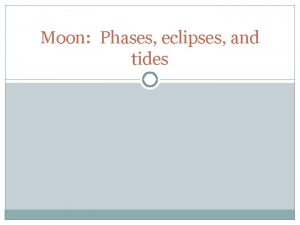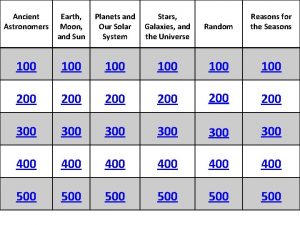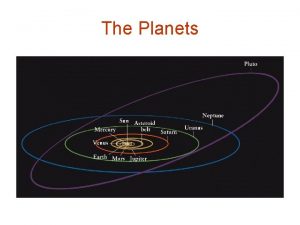Other than the sun planets and moon what

























- Slides: 25

Other than the sun, planets, and moon, what other objects are found in the Solar System?

In this lesson, we are going to be comparing comets, meteors, and asteroids which are found in the Solar System.

Essential Question: What is the difference between a comet, meteor, and asteroid? Standard S 6 E 1 f. Describe the characteristics of comets, asteroids, and meteors.

Activating Strategy Complete the “Before the Lesson” section of the Comets, Meteors, and Asteroids Anticipation Guide by selecting which object each statement describes based on your prior knowledge.

Comets http: //www. creationscience. com/onlinebook/Comets. html


Comets • Comets are composed of dust and rock mixed with frozen water, methane, and ammonia • Comets are considered to be like a large, dirty snowball

Comets travel around the sun in elliptical orbits http: //www. classzone. com/books/earth_science/terc/cont ent/visualizations/es 2706 page 01. cfm? chapter_no =visualization

Comets • When a comet nears the sun, some of it melts and forms a long tail (gases in the comet are vaporized by the sun) • A comet has 2 tails, a dust tail and a gas tail. • When a comet moves farther away from the sun, the tail disappears http: //www. windows 2 universe. org/comets/comet_model_interactive. html http: //www. solarsystemscope. com/ison/ http: //amazing-space. stsci. edu/resources/explorations/comets/lesson/make_nf. html

• PARTS OF A COMET

Nucleus: The nucleus is the frozen center of a comet’s head. It is composed of ice, gas, and dust. Coma: The coma is a blob of gas that surrounds the nucleus of a comet; The coma is composed of water vapor, carbon dioxide gas, ammonia, and dust. Gas Tail: A tail of charged gases (ions) always faces away from the sun because the solar wind. Dust Tail: The dust tail is a long, wide tail composed of tiny dust particles ; this tail curves slightly due to the comet's motion.


Where do comets come from? • Comets come from the Kuiper belt and Oort Cloud that is beyond Pluto’s orbit.

Asteroids

Asteroid • A piece of rock similar to the material formed into planets. • An Asteroid is smaller than a planet but larger than a meteoroid

Asteroid • Most asteroids are located in an area between the orbits of Mars and Jupiter called the Asteroid Belt. • Why are they located there? • The gravity of Jupiter might have kept a planet from forming in the area


You may have noticed that in the last slide we used the term Meteoroids to describe objects in the sky, but your essential question and the standard say Meteor. What’s the difference?

Meteoroid, Meteorite? The difference is just based on where the rock is located when you are describing it.

Meteoroid is a “space rock” that is still in space Meteor is a meteoroid that burns up in the earth’s atmosphere (called a Shooting Star) Meteorite is a meteoroid that hits the earth’s surface


A Meteor is considered harmless even though it can be viewed from earth at times.

Distributed Summarizing On your notes sheet, explain the difference between a comet, meteoroid, and meteor. When instructed, turn to an elbow partner and share your answer.


Summarizing Strategy Complete the “After the Lesson” section of the Comets, Meteors, and Asteroids Anticipation Guide by selecting which object each statement describes.
 What separates the inner and outer planets?
What separates the inner and outer planets? The inner solar system by leslie
The inner solar system by leslie Inner planets and outer planets
Inner planets and outer planets The first four outer planets do not have solid
The first four outer planets do not have solid Are jovian planets more dense than terrestrial
Are jovian planets more dense than terrestrial Duo servicekantoor
Duo servicekantoor Which moon phase occurs directly before a new moon
Which moon phase occurs directly before a new moon Moon sister moon calendar
Moon sister moon calendar Home.hiwaay.net/ krcool/astro/moon/moon tides/
Home.hiwaay.net/ krcool/astro/moon/moon tides/ What phase is this
What phase is this Diagram of earth moon and sun
Diagram of earth moon and sun When the sun passes between the moon and earth
When the sun passes between the moon and earth What is a tessellation?
What is a tessellation? How do the sun and moon work together
How do the sun and moon work together What season is this
What season is this Moon
Moon New moon position of sun and earth
New moon position of sun and earth Earth sun relationship
Earth sun relationship Moon and sun comparison
Moon and sun comparison 14 rajlok jain
14 rajlok jain How the sun and moon work
How the sun and moon work How does the sun moon and earth work together
How does the sun moon and earth work together Personification examples for moon
Personification examples for moon Magic school bus sun and moon
Magic school bus sun and moon Phases of the moon sun on left
Phases of the moon sun on left The sun-earth-moon system worksheet answers lesson 1
The sun-earth-moon system worksheet answers lesson 1






